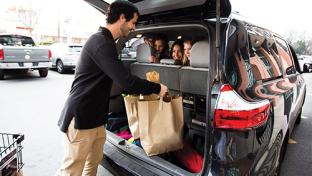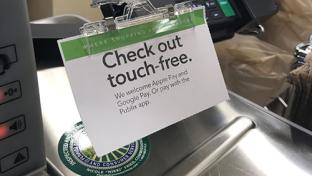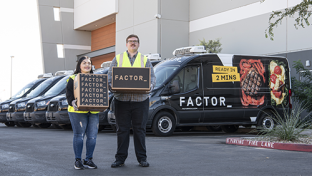What’s Next for Food Retail Self-Checkout?
Fast, easy and helpful — those were some of the early reviews of Walmart’s new experiment with self-checkout, an effort that could help influence the broader future of the transaction method for food retailers.
Earlier this year, the chain started to test its latest checkout method at a supercenter in Fayetteville, Ark. The layout isn’t complex. Instead of dedicated checkout lanes, there’s an open, relatively expansive self-checkout area designed to meet consumer demand as it happens.
Key Takeaways
- A fresh wave of innovation in self-checkout and other payment systems appears ready to hit the food retail world.
- Wegmans, Costco and large other food retailers are helping to lead the self-checkout charge, along with convenience store chains.
- Retailers should think of self-checkout as a part of the larger customer journey, and take steps to make shoppers feel confident with new technology.
The effort, still only a few months old, comes amid a spike in contactless transactions for food retailers, a trend that existed before the pandemic and has gained fresh steam during the outbreak. According to London-based research firm RBR, in fact, the self-checkout momentum will continue, with global installations expected to triple by 2025 to surpass 1.1 million.
A fresh wave of innovation in self-checkout — and payments in general — appears ready to hit the food retail world, where younger, tech-savvy consumers are making their desires known, and where new technology is becoming more affordable and convenient for smaller and midsize retailers.
Self-Checkout Pros and Cons
Bentonville, Ark.-based Walmart provides one idea of how the future of self-checkout might play out.
For the experiment in Fayetteville, Walmart set up 34 registers that line the edge of an open area. Each register has a green light that directs employees and customers to available checkout bays, which could save the annoyance of standing in a slow-moving traditional checkout lane.
Customers aren’t left on their own, however. Walmart’s self-checkout comes with a certain level of built-in hand-holding: Employees greet shoppers at the entry to the new checkout area and offered help proactively.
Early results from a mystery shopping survey, conducted by Fayetteville-based Field Agent, gave reason for optimism. Users liked the number of associates ready to help, and the overall speed of the self-checkout process at Walmart.
As for faults with the system, some shoppers were turned off by such issues as “the crowd of shoppers [and] associates,” self-checkout stations “situated too close to one another” and the “impersonal” feel of the process.
Self-Checkout Growth
Not every retail experience resembles shopping at a Walmart Supercenter, of course, but merchants are best served to take such initial concerns seriously, given the growth of self-checkout generally.

According to RBR, global shipments of self-checkout terminals increased 52% year over year in 2019, with that growth driven by the U.S. market, including food retailers.
Wegmans, Costco and other large food retailers are helping to lead the charge, with convenience store chains also getting involved. “The COVID-19 crisis will only embolden long-standing and new self-checkout proponents alike to speed up expansion plans, with customers increasingly expecting such solutions as part of a wider array of checkout options,” says Alan Burt, who led the RBR research.
New Wave of Self-Checkout
Walmart and Amazon might get much of the attention when it comes to self-checkout technology — Seattle-based Amazon, of course, for its work on computer vision technology and store sensors to enable grocery shoppers to walk out of the store and have payments automatically deducted from their accounts. But other food retailers are deploying the newest self-checkout technology, even if it’s less sophisticated or futuristic than the technology being used by Amazon.
In late July, for instance, Chandler, Ariz.-based Bashas’ went live with NCR Emerald, described as the next-generation, cloud-enabled point-of-sale (POS) platform offered on a subscription basis for grocers. The new system eventually will come to include all software and payments processing for full and self-service checkouts, plus technology for customer loyalty, promotions, merchandising and more.
Featuring a cloud-enabled, API-first infrastructure, NCR Emerald integrates with other applications in the retailer ecosystem and promotes consistency of capabilities across physical stores and digital channels. Its subscription pricing model reduces upfront investment, so retailers can reallocate resources to improve the customer experience.
The Bashas’ deployment came as Atlanta-based NCR experienced a doubling of shelf-checkout shipments in 2019 and ongoing acceleration in 2020, according to David Wilkinson, president and general manager, NCR Retail.
“Even though 2020 has been a year like no other, we still see an acceleration in retailers adopting self-checkout,” Wilkinson says. “Overall, we are seeing increased deployments across all grocery formats large and small, not just limited to the national, global players, but also among independents. As more and more retail segments outside the traditional grocery chains, like convenience and discounters, are adopting self-checkout, we expect this trend to continue in 2021.”
Making Self-Checkout Better
Self-checkout not only helps retailers keep lanes open and business flowing — which in turn can cut down lines or waits during an era of pandemic-inspired store customer limits — but it can also serve as a customer retention and satisfaction tool.
Cambridge, Mass.-based Forrester Consulting, for instance, has found that 97% of U.S. grocery shoppers view long food retail lines as a deterrent — and that 65% of those shoppers are willing to head toward self-checkout machines if staffed checkout lines are too busy. That’s a fair amount of opportunity for food retailers. That said, it’s still too early to detail revenue gains made via the deployment of newer self-checkout technology, but you can bet that numbers will be coming soon enough.
Food retailers can’t just put in a few self-checkout lines and forget about them. For various reasons — fraud and age verification among them — a certain amount of friction or shopper reassurance is still needed when it comes to self-checkout, especially as many consumers take their time getting used to the new technology. (Cash still accounts for about a fifth of all U.S. food retail transactions, according to the National Grocers Association and Bankrate — a signal of how relatively old-fashioned many grocery transactions remain.) Retailers must think of self-checkout as a part of the larger customer journey, and take appropriate steps that serve to make shoppers feel confident with new technology.
“Our insights also show that customers do want to have the final acknowledgment that payment has been completed,” Wilkinson says. “They do not want to be perceived as ‘stealing.’”
That’s not all that food retailers must do to ensure the success of self-checkout and mobile payment innovations, notes Christian Floerkemeier, co-founder and chief technology officer of Zurich, Switzerland-based barcode-scanning technology provider Scandit.
"If it doesn’t work, consumers won’t give it a second chance,” notes Floerkemeier. “If you don’t have the store manager, the employees on board — if they don’t actually encourage it, but see it as a threat to their jobs — you will fail.”
What’s Next
The coming months and years promise to bring more affordable, often off-the-shelf self-checkout technology to more food retailers such as Walmart, Amazon, and other companies. NCR offers a glimpse of one way that might happen.

“Our approach leverages micro-services, AI, [application programming interfaces] and virtualization to fundamentally change the cost curve to deploy new technologies in the store,” Wilkinson explains. “This open approach also allows retailers to leverage innovation from not only NCR, but from in-house development or third parties. When a retailer invests in this architecture, like self-checkout innovation, they immediately have a path towards innovation.”
Food retailers are also trying to hold fast to payment and checkout changes made during the pandemic, and turn them into long-term gains.
The Kroger Co., for example, is bullish on its own contactless payment efforts, and executives at the Cincinnati-based retailer seem determined to move the ball significantly forward.
“We were able to quickly offer and promote on-demand, no-contact delivery and low-contact pickup services” during the crisis, says CEO Rodney McMullen. “We expanded and improved contact-free payment solutions like Scan, Bag and Go and Kroger Pay.”
Consumers’ smartphones look certain to play a larger role in food retail self-checkout experiences, a result of more movement toward mobile commerce in general, especially among younger shoppers. Such a program could take the form of Meijer’s Shop & Scan technology, for instance. A mobile app enables customers at the Grand Rapids, Mich.-based retailer to shop and bag as they go, letting them avoid lines and personalize their shopping.
According to Floerkemeier, Scandit’s barcode-scanning software enables retailers to offer quicker self-checkout payment service without having to invest Amazon-level capital to do so, or to refurbish existing stores when deploying sensors and associated technology. The road to even more contactless food retail payments in the United States remains a long one; after all, the country lagged behind much of the rest of the world in adopting basic contactless retail transactions.
With its own self-checkout experience, Walmart seems to have grasped that lesson, highlighting the role that its cashiers are playing in this new transaction process, and finding efficiencies there as well. A cashier staffing a traditional checkout lane needs some 40 hours of training before taking over a register, Walmart notes, but only a day for the new self-checkout process.
The retailer also touts another benefit for its front-line workers: a brighter mood from interacting with shoppers.
“Getting that personal face-to-face conversation, it’s really nice,” says Matt Downing, front end team leader at the Fayetteville store testing the self-checkout system. “I’ve noticed ... that it’s helped me be more positive and more outgoing to new people.”
Whether that remains the case won’t be clear for some time, but self-checkout promises to play a bigger role for more food retailers in 2021.








